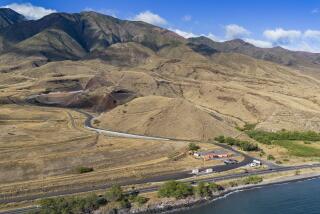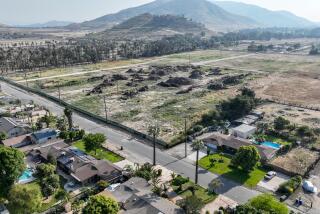Racism Seen in Selection of Nuclear Dump Site
- Share via
FORT HANCOCK, Tex. — Opponents battling a proposed nuclear waste dump in west Texas say racism may have been a factor in the decision to locate it in heavily Hispanic Hudspeth County.
The Texas Low-Level Radioactive Waste Disposal Authority has been under fire in recent months for deciding to put a waste dump near this farming and ranching community of 300.
Rick Jacobi, authority executive director, called the race-discrimination accusation “absolute nonsense.”
The proposed 60,000-acre waste dump would be located 11 miles northeast of Fort Hancock, 13 miles east of the El Paso County line, 37 miles from the El Paso city limits and 14 miles north of the Rio Grande.
At a meeting with authority members at Fort Hancock, the Rev. James Hall, pastor of Santa Teresa Roman Catholic Church, said the proposed site near Fort Hancock may be part of a national trend to locate such facilities in areas dominated by minorities.
Study Cited
Hall cited a recently completed study by the Commission for Racial Justice of the United Church of Christ which indicates hazardous waste dumps are located in communities characterized by a heavy minority population who are economically disadvantaged and politically powerless.
“The demographics of the town of Fort Hancock had nothing to do with the selection of the site,” Jacobi said. “The report is erroneous in its assumptions.”
Hall disagrees.
“The study concludes that this factor of race is a more significant factor than any other in determining the location of hazardous waste dumps,” Hall said. “It is a well-known fact that racial minorities in this country are also much more negatively impacted economically.”
Hall said the population of Hudspeth County is about 73% Hispanic. He said the per capita income in Fort Hancock and other towns in Hudspeth County is far lower than the national average.
The report, Toxic Wastes and Race, was supplemented by data from Public Data Access Inc., United Church of Christ officials said.
The report states: “The findings suggests the existence of clear patterns which show that communities with greater minority percentages of the population are more likely to be the sites of such facilities.
“The possibility that these patterns resulted by chance is virtually zero.”
Seven Areas
The report singled out seven areas of the country as particularly dangerous and demanding immediate attention because of the number of waste sites and heavy minority populations.
The areas cited by the study include Houston, Memphis, St. Louis, Cleveland, Chicago, Atlanta and Los Angeles, all areas with a heavy black or Hispanic population.
San Antonio and Albuquerque were also cited as needing attention.
Authority members heard testimony in May from Hall and other opponents who crowded into the Fort Hancock Community Center to register their objections to location of the site in west Texas.
Among the opponents was State Sen. Tati Santiesteban (D-El Paso), who said he has been fighting in the Legislature to keep the dump out of Fort Hancock.
“It’s a losing battle,” he said. “In west Texas there are only a handful of senators, compared to more than 30 in east Texas. The state is dumping on us because they know they have the votes in the Legislature.”
But officials of Hudspeth County are not quitting the battle.
Joining in the fray are representatives of neighboring El Paso County, several water improvement districts in both counties, citizens from surrounding Mexican farm communities and members of the El Paso Interreligious Sponsoring Organization (EPISO), an Industrial Areas Foundation organization.
El Paso County Attorney Joe Lucas said opponents of the waste dump site have filed a lawsuit against the authority. The plaintiffs contend:
- The Fort Hancock site is too close to the Rio Grande, with the danger of contaminating communities on both sides of the U.S.-Mexico border;
- A number of constitutional rights of residents are being violated. Opponents say the authority has disregarded its own rules for the selection of sites;
- There is danger to the community if the dump site leaks into underground aquifers.
“There will be no danger to Fort Hancock or surrounding areas,” Jacobi countered. “The proposed site will be safe. It will be the finest such facility in the world.”
Upcoming Trial
Lucas said the trial will be held sometime before the end of the year.
Hall said he is counting on the courts for a just decision. He said the authority’s contention that the waste to be deposited in Fort Hancock is not dangerous just does not ring true.
“If it’s not dangerous, why don’t you build the dump in (the Texas capital of) Austin?” he asked authority members at the May hearing.
Hall said 90% of the nuclear waste to be deposited in the proposed dump site at Fort Hancock will be produced in the metropolitan areas of Houston, Dallas-Fort Worth, San Antonio and Austin.
More to Read
Sign up for Essential California
The most important California stories and recommendations in your inbox every morning.
You may occasionally receive promotional content from the Los Angeles Times.










